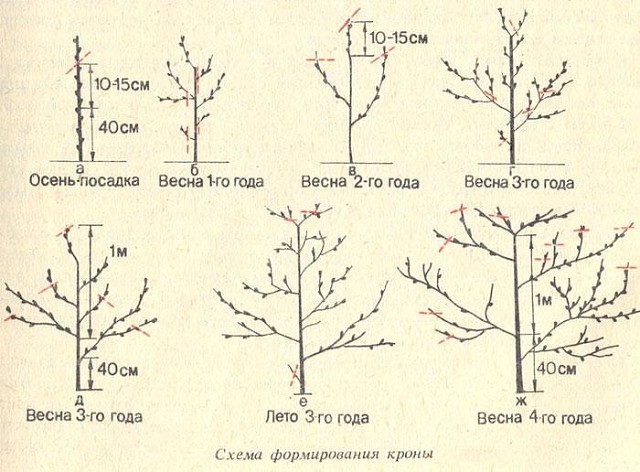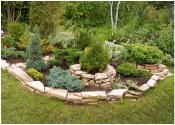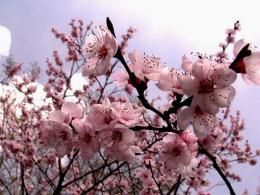Search
Login
Apricot: planting, growing, pruning
Apricot is an early-flowering beautiful tree, it is delicious fruits, it is vitamins and minerals. Fresh apricots are absolutely harmless to everyone, even those who are overweight. Therefore, every gardener wants to have this tree on his plot.
Content
- The acquisition of apricot seedlings video
- Apricot planting video
- Apricot pruning
- Apricot Care Rules video
- Apricot pruning video video
The acquisition of apricot seedlings
The best planting material is a well-developed seedling of the first year.
Such seedlings take root better, are more convenient for crown formation.
It is necessary to purchase seedlings in specialized stores or nurseries, by purchasing a seedling of random origin, you can get a seedling (spade) instead of an apricot.
Saplings of cultivated varieties do not have thorns, the annual branches of an apricot seedling are thick;
Saplings with a dried root or with a frozen above-ground system do not take root.
Apricot planting
The best time for planting apricot is early spring.
At the same time, if the spring is rainy, an excellent survival rate of the seedling is provided. Wearing sports sweatshirts, we plant seedlings in pre-prepared pits, which are prepared in the fall, measuring 80x80x80 cm.
2-3 buckets of humus or ripened compost, 500 grams of superphosphate, 2 kilograms of ash are introduced into the pit, all this is thoroughly mixed, the pit is filled with this soil mixture at 1/3 depth, a mound of soil mixture is made in the center of the pit so that the apricot grafted on a seed stock, the root neck was 5-6 cm below the edges of the pit for chernozem and 10-12 cm for sandy soils
In plants grafted on clonal stocks, the site of vaccination is placed at the level of the hill.
Before planting, the roots of an apricot seedling are dipped in a soil mash.
Having set the plant on a knoll, the roots are filled with a mixture prepared in advance, the upper layer of the backfill is made with soil from the lower layers of the dug pit, the soil is compacted, an earth roll up to 10 cm high is made around the planting pit so that the water does not flow during irrigation.
It is better to plant three plants of different ripening periods on the plot, the need for such an amount is due to the fact that most apricot varieties are partially self-fertile and do not produce high yields without cross-pollinating flowers with pollen from other varieties.
After planting, seedlings are watered with 2-3 buckets of water, the settled soil is sprinkled to the previous level.
Apricot pruning
Planted annuals are cut at a height of 30 cm from the soil surface. Of the remaining buds on the stem, lateral spring shoots develop and the shoot is a continuation of the stem.
a) pruning after planting, b) in the spring of the second year, c) in the spring of the third year, d) in the spring of the fourth year

Apricot Care Rules
In the first two years after planting a seedling, the apricot trunk circle is kept in a loose, weed-free state or under organic mulch. If there is good watering, the soil can be kept under the sod of perennial grasses, when the grass grows to 20-25 cm, it is mowed.
If the near-stem circle is kept in a loose state, the depth of cultivation under the crown should not exceed 6-8 cm to prevent injury and cutting of the roots.
Before fruiting, organic and phosphorus-potassium fertilizers can be omitted, nitrogen fertilizers must be applied annually at 20-30 grams per square meter in two periods: in spring and after harvesting in half doses.
After the fruiting of the apricot begins, it is necessary to add 30 grams of ammonium nitrate, 8 grams of superphosphate, 20 grams of potassium salt per square meter of the trunks annually.
Organic fertilizers are applied once every 3-4 years, if apricots grow under sod, organic fertilizers do not.
Apricot responds well to nitrogen fertilizers, but their excess reduces the resistance of plants to diseases, causes gum disease, delays the ripening of fruits, and leads to extra-long growths (more than 100 cm).
On heavy and acidic soils, apricot reacts positively to the addition of calcium. It is better to apply fertilizer in a liquid state, in a dry form it is applied to the grooves or to the wells before irrigation.
During the period of solidification of seeds, the active growth of fruits and shoots, apricot requires abundant watering.
Overloading trees with fruits leads to their weakening and poor fruit setting in the next year. Therefore, it is necessary to carry out annual spring pruning of trees, in addition, manual thinning of the fruits after shedding the ovary is recommended.
The correct ratio between the number of fruits and leaves in apricot is 1:20.
Before manual thinning, the tree is shaken so that underdeveloped, sick and damaged fruits fall, then defective, poorly located and crowded fruits are removed.
It is necessary to observe phyto-sanitary hygiene:
- remove all diseased branches and shoots, burn them;
- clean wounds, disinfect and putty them;
- to collect and burn carrion and sick fruits;
- collection and burning of diseased leaves;
- annual disinfection of wood with a solution of lime (in autumn or early spring);
- annual binding of the central conductor and the base of the skeletal branches with thick paper or other material to protect the plant from sunburn and rodents in the winter.
Apricot pruning
With good quality planting material and good care, spring shoots grow quickly and summer shoots appear. This property must be used during the formation and fruiting period of the plant, for which spring sharp-angle shoots should be pinched over 2-3 leaves, shoots selected as skeletal ones should be pinched over the fifth sheet.
In summer (July), the shoots from which the skeletal branches form are nipped at a length of 30 cm. At the same time, the extension of the stem is nipped and pinched.
The following year, in the spring, annual growths are subjected to spring pruning.
On skeletal, semi-skeletal branches and the central conductor, they are shortened by 1 \\ 2 of their length, and weak annual growths of other branches are shortened by 1 \\ 3-1 \\ 4 of their length.
Further, spring shoots that have appeared are subjected to summer pruning, 20-30 days after spring shoots by 1/2 of their length when growing more than 40 cm, and pinch shoots up to 15 cm long are pinched over a normally developed leaf.
Apricot mainly bears fruit on annual branches of different lengths, as well as on special fruitful formations - spurs and bouquet branches.

The main task of pruning apricot trees is to ensure the annual formation of new, sufficiently strong shoots.
On elongated shoots, in comparison with short shoots, fruit buds are laid later, late buds better tolerate provocative warming in the winter.
For 2-3 years of the tree’s life, they continue moderate shortening of the main branches and the central conductor, observing the rules for the subordination of branches in the crown.
The degree of trimming is increased in weakly branching varieties and vice versa, reduced with strong-medium branching.
After the transition of the tree to fruiting, shortening is weakened, and with strong branching, temporarily stop and increase thinning.
Pruning, bearing fruiting, increases the resistance of trees to low temperatures.
In addition, apricot trees like a landing site where there is no wind.





